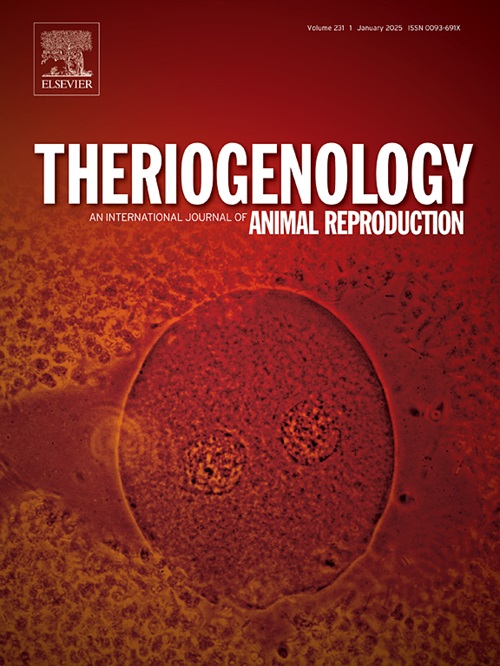富血小板血浆能有效治疗用冷冻驴精液授精的珍妮的子宫炎症吗?
IF 2.4
2区 农林科学
Q3 REPRODUCTIVE BIOLOGY
引用次数: 0
摘要
尽管冷冻驴精液在解冻后显示出很高的质量,在母马身上也能达到合适的受孕率,但在珍妮身上的结果却不尽如人意,这可能是由于子宫炎症反应较强所致。本研究评估了富血小板血浆(PRP)对用冷冻驴精液人工授精的珍妮子宫炎症和受孕率的影响。将 11 只骒马的发情周期分为三组:对照组(CTR,n = 22),不进行任何治疗;单次PRP输注组(S-PRP,n = 22),在人工授精(AI)前排卵诱导30小时后输注;双次PRP输注组(D-PRP,n = 21),第一次输注在排卵诱导后30小时,第二次输注在人工授精后4小时。用冷冻驴精液(10 亿个精子)进行人工授精,在排卵后立即将精液注入子宫角深处。对人工授精前(TCt)和人工授精后(6、24 和 48 小时)的子宫内膜水肿、宫腔内积液(IUF)、子宫血管和子宫内膜细胞学进行评估。在 T48 时进行子宫活检,以进行组织病理学和胶原蛋白评估。在 D5 采集外周血样本以测定血清孕酮,在 D14 通过超声波检查评估妊娠情况。在 SAS 和 GraphPad Prism 中使用 GLMM、方差分析、Friedman 和 Kruskal-Wallis 检验对数据进行分析,显著性设定为 P本文章由计算机程序翻译,如有差异,请以英文原文为准。
Is platelet-rich plasma effective in treating uterine inflammation in jennies inseminated with cryopreserved donkey semen?
Despite frozen donkey semen demonstrating high quality after thawing and achieving suitable pregnancy rates in mares, it yields unsatisfactory results in jennies, likely due to a stronger uterine inflammatory response. This study assessed the effects of platelet-rich plasma (PRP) on uterine inflammation and pregnancy rates in jennies inseminated with frozen donkey semen. Estrous cycles from 11 jennies were assigned to three groups: Control (CTR, n = 22) with no treatment; Single PRP infusion (S-PRP, n = 22) administered 30 h after ovulation induction, prior to artificial insemination (AI); and Double PRP infusion (D-PRP, n = 21) with the first infusion at 30 h after ovulation induction and the second 4 h after AI. Insemination was performed with frozen donkey semen (1 billion sperm) deposited deeply in the uterine horn immediately after ovulation. Endometrial edema, intrauterine fluid (IUF), uterine vascularization, and endometrial cytology were evaluated pre-AI (TCt) and post-AI (6, 24, and 48 h). Uterine biopsies were taken at T48 for histopathological and collagen evaluation. Peripheral blood samples were collected on D5 for serum progesterone measurement, and pregnancy was evaluated via ultrasonography on D14. Data were analyzed using GLMMs, ANOVA, Friedman, and Kruskal-Wallis tests in SAS and GraphPad Prism, with significance set at p < 0.05. The S-PRP group showed less IUF accumulation than the CTR group at T6. Other parameters showed no significant differences among the groups. Cytology revealed a high percentage of inflammatory cells at T6 in all groups, which decreased in subsequent evaluations. In the CTR group, neutrophil percentages were similar to TCt at T24, while treated groups reached this similarity only by T48. Eosinophil percentages increased over time only in the treated groups. Pregnancy rates showed no differences among the groups (CTR: 0 %, S-PRP: 0 %, D-PRP: 10 %). Results indicate that PRP treatments were ineffective in modulating uterine inflammation and did not enhance pregnancy rates in jennies inseminated with frozen donkey semen.
求助全文
通过发布文献求助,成功后即可免费获取论文全文。
去求助
来源期刊

Theriogenology
农林科学-生殖生物学
CiteScore
5.50
自引率
14.30%
发文量
387
审稿时长
72 days
期刊介绍:
Theriogenology provides an international forum for researchers, clinicians, and industry professionals in animal reproductive biology. This acclaimed journal publishes articles on a wide range of topics in reproductive and developmental biology, of domestic mammal, avian, and aquatic species as well as wild species which are the object of veterinary care in research or conservation programs.
 求助内容:
求助内容: 应助结果提醒方式:
应助结果提醒方式:


